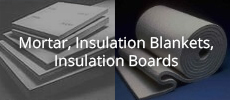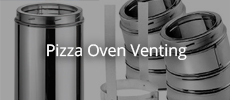Would you kindly indicate what formula is used to work out the following:
1- Flue diameter.
2- The Air chamber (The chamber between the entry point to the dome and the entry point to the oven (Oven door)
Announcement
Collapse
No announcement yet.
Question about flue depth to oven size ratio
Collapse
X
-
Thanks for the instructions I really appreciate it! This will be my plan A - to cast an anchor piece based on 2 different diameters as you say. Will try to find pipes of the right diameter. Plan B is to finally buy an arc welder and some SS and pipe and try to weld my own anchor plate.
Leave a comment:
-
You could cast a collar on top of the square or rectangular hole using either castable refractory or homebrew. Use a short (around 100 mm long) length of 6” pipe, wrapped in plastic for easy removal. A larger one hat under 8” around it then fill the space between these two. On removal of both inner and outer mould walls you will be left with a suitable base for both inner and outer flue pipes.
Leave a comment:
-
Hello David, May I ask for your input/opinion? Basically in Japan it has been impossible to find anywhere that sells stove anchor plates. I can get them internationally but I don't want to order a SS chimney that matches this anchor plate from overseas as shipping is several hundred dollars and very likely to arrive here dented. So other option, I found a local place that sells SS single wall 15cm/6" pipes (79cm effective length) that look like they would work on my 31" dome. SS thickness is only 0,3-0,4mm so heat expansion likely would not be an issue there as they're so thin. But the anchor plate system (Selkirk) I can get overseas is unlikely to fit a domestic 6" single wall pipe. So maybe I need to devise alternative solution - mounting pipe without anchor plate.Originally posted by david s View Post120 mm is less than 5” and will result in smoke issues out the mouth of your oven. Although once the oven is up to a reasonable temperature after around 1/2 hr the draw will be sufficient. You could try extending the flue height to increase the draw, but a 6” pipe is a better solution as diameter has a more powerful effect than height. Using a double walled flue will not affect the draw, it only stops people getting burnt from touching the hot pipe, or preventing excessive heat if it penetrates a roof. It also doubles your cost.
Without an anchor plate, then how can I improvise a way to connect the chimney to the flue area? My plan is still to do a brick flue - serpentine design. I know you cast flue areas, but I saw on another post you don't use anchor plates but cut small notches into the chimney and then in the case of a brick flue- how would you fasten it between bricks?
Also, if I want to later upgrade from 6" diameter pipe to a double wall pipe, how could I do that, given the hole for a double wall 6" pipe would have to be 8".
Anyway, those are the things that keep me from pulling the trigger at the moment and continue my build. So I thought I'd put it out there to hear from you or others who have decades of experience building WFOs.
Cheers,
Leave a comment:
-
120 mm is less than 5” and will result in smoke issues out the mouth of your oven. Although once the oven is up to a reasonable temperature after around 1/2 hr the draw will be sufficient. You could try extending the flue height to increase the draw, but a 6” pipe is a better solution as diameter has a more powerful effect than height. Using a double walled flue will not affect the draw, it only stops people getting burnt from touching the hot pipe, or preventing excessive heat if it penetrates a roof. It also doubles your cost.Last edited by david s; 01-28-2020, 12:24 PM.
Leave a comment:
-
Thanks David for this info, so basically you're saying that I could in theory have a chimney entry from the flue sized as little as roughly 20 square inches? Following the high school formula of 3.14 * (2.5 ^ 2) = 19,625, so that would mean I could have a 5 inch diameter chimney entry, as long as my flue gallery is roomy enough and I have some type of chimney on top. On chimney, I have easy access to several pieces of chimney, but they are only single walled and only 12cm in diameter, so that's a good inch less than the 6 inches pipe I actually need. What is your advice, can I use those smaller single walled pipes or should go for a double walled 15cm/6" pipe to be sure that there's enough draw? Is single wall a risk for cracking the flue area? By the way I've seen your amazing builds here, and wow-great inspiration from the Barcelona Sagrada Familia!
I noticed the forum is a bit wonky, I was not notified you replied to this thread, therefore my slow response.
Leave a comment:
-
Regarding the flue size, a 6” diam pipe is correct for your oven size. It’s cross sectional area is 28 square inches. The entry point where brick meets flue pipe can actually be up to 30% less in cross sectional area as at that point a restriction there simply acts as a Venturi with smoke accelerating at that point. Provided the volume beneath it is larger. In other words the flue gallery should be shaped like an inverted funnel for the smoke to collect. The draw from the flue is governed by primarily it’s diameter and then it’s height. It’s power will easily overcome a slight restriction at the base of the pipe.
Leave a comment:
-
Question about flue depth to oven size ratio
My oven dome is around 32". From that I've read between 32-36" oven size that a 6" flue will be appropriate. Then I've also read that a flue exit into the chimney should be around 50 square inches. So that would mean I need to anticipate a 6" deep/8" wide end point of the brick flue, at least that would get me to 48 square inches, and just about enough. Am I off on these assumptions?
Also, I need to figure out the depth of the flue/entry area. Since my dome is about 32", would it be enough if I used 4/3 firebrick depth of flue? With that, I would use 1/3rd (3") as link to the inner arch with fire rope and refractory sealer cutting notches into the brick and placing those on top of the inner arch like others did it (for example JR Pizza). That would give me 2/3rd bricks (6") as middle area of the flue arch to move upwards and turn into serpentine style flue, and then a last 3rd brick on the outside (3") would be for the outer arch. Does this make sense, and would this be deep enough and strong enough to accommodate the chimney? Especially, would a 3 inch brick arch on the outside of the flue area be strong enough to hold up on its own? I can't see from the photos in other posts of this forum how large the brick pieces others have used were.
Any inputs or opinions would be great.Tags: None





Leave a comment: